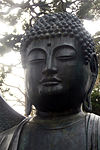Sanbo Kyodan
This article may be unbalanced toward certain viewpoints. (December 2010) |
 Haku'un Yasutani (right) | |
| Formation | 1954 |
|---|---|
| Type | Zen |
| Headquarters | |
| Website | Sanbo-Zen.org |
| Part of a series on |
| Zen Buddhism |
|---|
 |
| Part of a series on |
| Western Buddhism |
|---|
 |
Sanbo Kyodan (三宝教団, Sanbō Kyōdan, literally "Three Treasures Religious Organization") is a Zen sect derived from both the Rinzai and Soto traditions of Japanese Zen.
History
Sanbo Kyodan was founded by Yasutani Haku'un in 1954. It is rooted in the thinking of Harada Daiun Sogaku, who studied with Rinzai priests.[1] Both Harada Roshi and Yasutani Roshi were strong promoters of Zen practice for people of other (non-Buddhist, non-Asian) faith communities and cultures. Their influence has been largely responsible for the flourishing of Zen practice and teachings in North America and Europe in the latter half of the 20th century and early 21st century.
Influence
Perhaps the best-known adherent of Zen in the United States, Roshi Philip Kapleau (author of the landmark guide to Zen practice "The Three Pillars of Zen") trained under both Harada Roshi and Yasutani Roshi at their monastery in Kamakura, Japan in the 1950s and 1960s.
Another influential student was Taizan Maezumi, who gave dharma transmission to various American students, among who are Tetsugen Bernard Glassman, Dennis Genpo Merzel, Charlotte Joko Beck and John Daido Loori.
In Europe the Sanbo Kyodan has been influential via Hugo Enomiya-Lassalle, and via students of Dennis Genpo Merzel, especially in the Netherlands.
Sanbo Kyodan was also connected to the Soen Nakagawa-Eido Tai Shimano lineage, due to a personal fondness of soen for the teaching practices of Harada roshi.[2]
Yasutani and Japanese imperialism
Yasutani's support for the Japanese military's aggression against other Asian countries, most of which were Buddhist, was criticised after World War II. The publication of Brian Victoria's Zen at War[3] led to a public apology by Kubota Ji'un, the 3rd Abbot of Sanbô Kyôdan.[4]
See also
Further reading
- Philip Kapleau, The Tree Pillars of Zen
- Peter Matthissen, Nine-headed Dragon River
- Brian Daizen Victoria (2006), Zen at war. Lanham e.a.: Rowman & Littlefield Publishers, Inc. (Second Edition)
External links
Notes
- ^ Page 148. Ford, James Ishmael (2006). Zen Master Who?: A Guide to the People and Stories of Zen. Wisdom Publications. ISBN 0-86171-509-8.
{{cite book}}: Cite has empty unknown parameter:|coauthors=(help) - ^ Eido Tai Shimano (1996), Dai Bosatsu Mandala. A Portrait of Soen Nakagawa. In: Kazuaki Tanahashi & Roko Sherry Chayat (1996), Endless Vow. The Zen Path of Soen Nakagawa. Boston, Massachusetts: Shambhala Publications, Inc. Page 20-21
- ^ Victoria, Brian Daizen (2006), Zen at War. Lanham e.a.: Rowman & Littlefield Publishers, Inc. (Second Edition)
- ^ Apology for What the Founder of the Sanbô Kyôdan, Yasutani Haku'un Roshi, Said and Did During World War II
References
- Ford, James Ishmael (2006). Zen Master Who?: A Guide to the People and Stories of Zen. Wisdom Publications. ISBN 0-86171-509-8.
{{cite book}}: Cite has empty unknown parameter:|coauthors=(help) - Prebish, Charles S. (1999). Luminous Passage: The Practice and Study of Buddhism in America. University of California Press. ISBN 052021697.
{{cite book}}: Check|isbn=value: length (help); Cite has empty unknown parameter:|coauthors=(help) - Seager, Richard Hughes (2000). Buddhism in America. Columbia University Press. ISBN 0-231-10868-0.
{{cite book}}: Cite has empty unknown parameter:|coauthors=(help) - Spuler, Michelle (2002). Developments in Australian Buddhism: Facets of the Diamond. Routledge. ISBN 0-7007-1582-7.
{{cite book}}: Cite has empty unknown parameter:|coauthors=(help)
